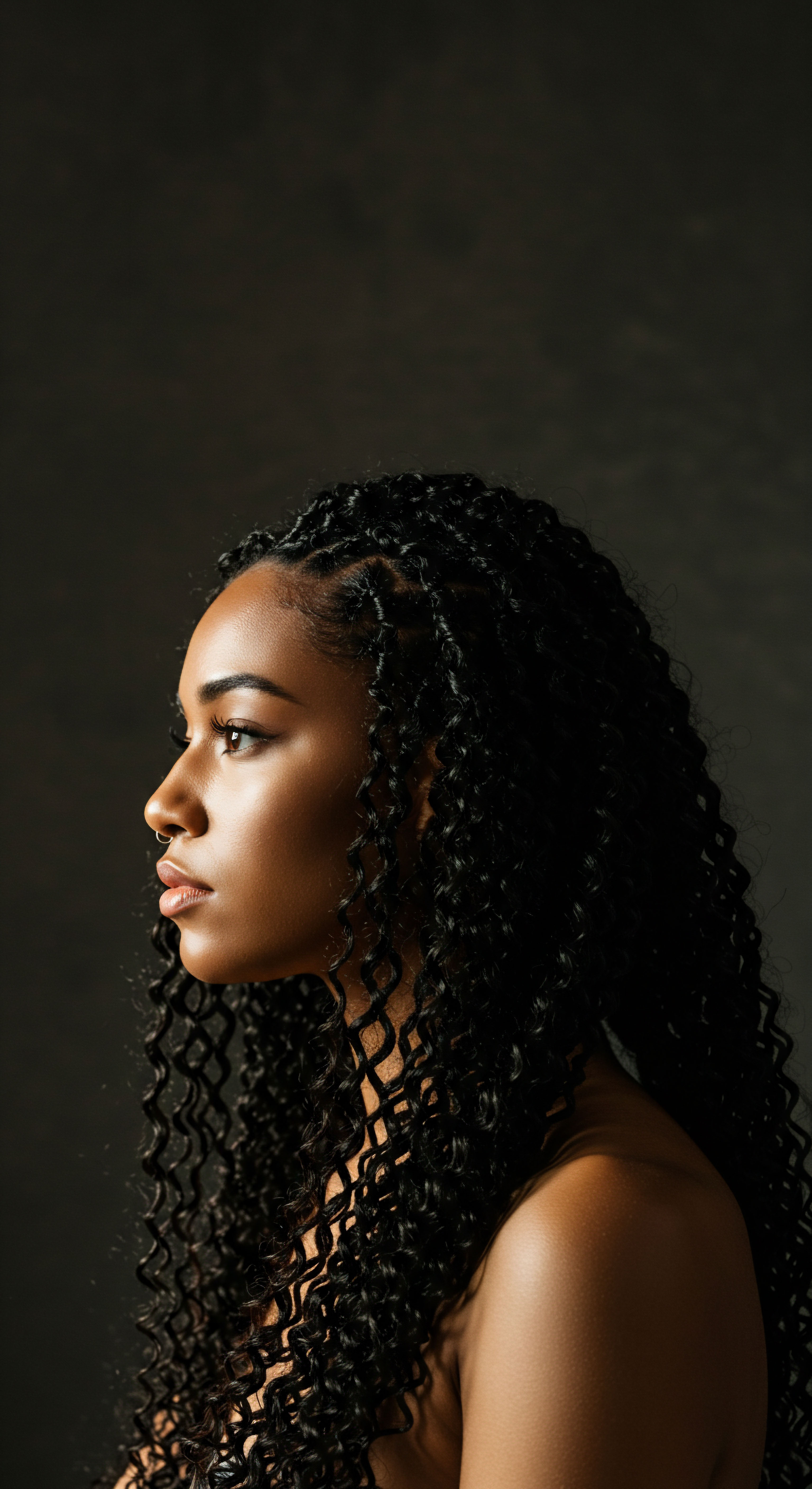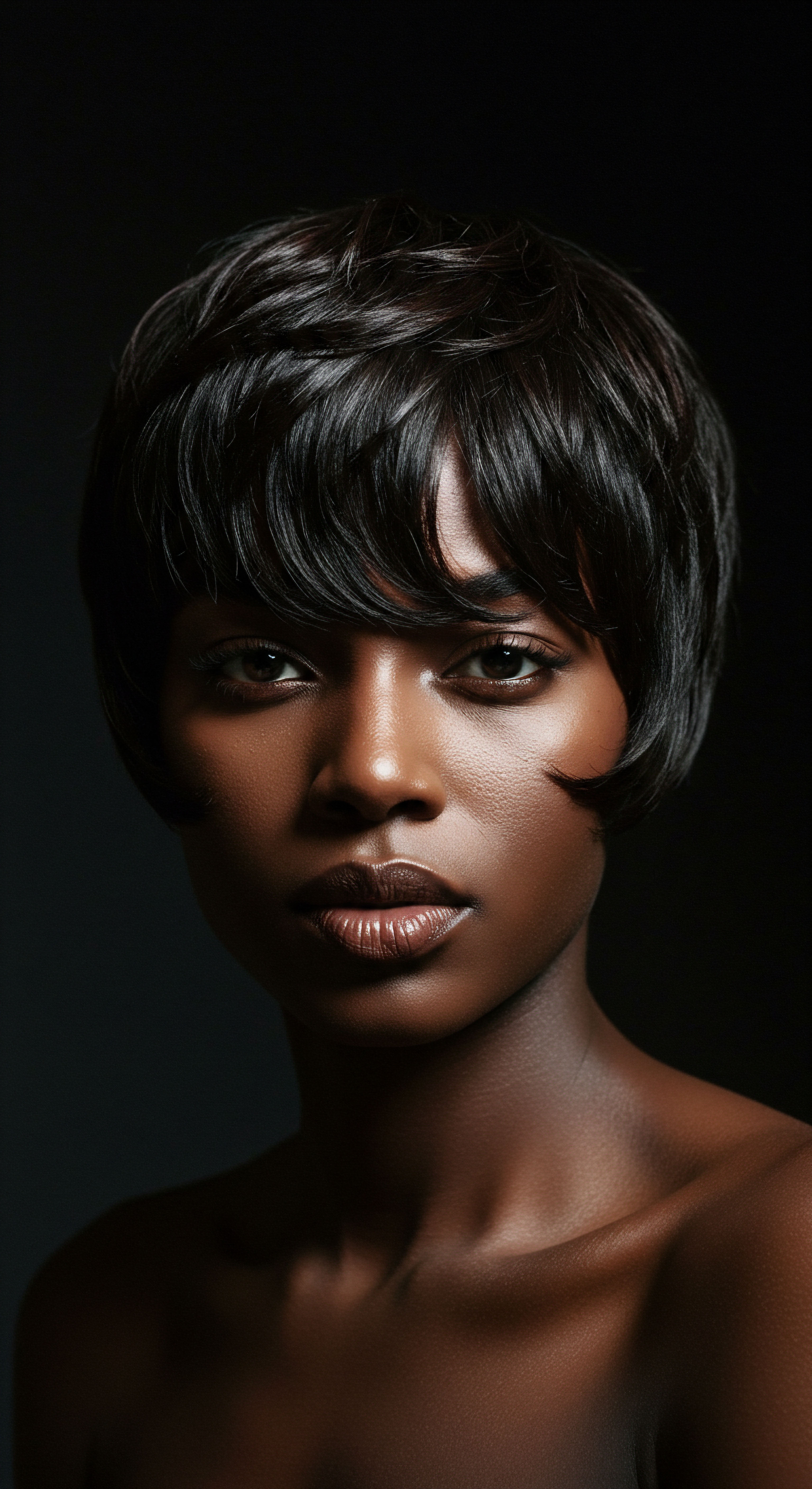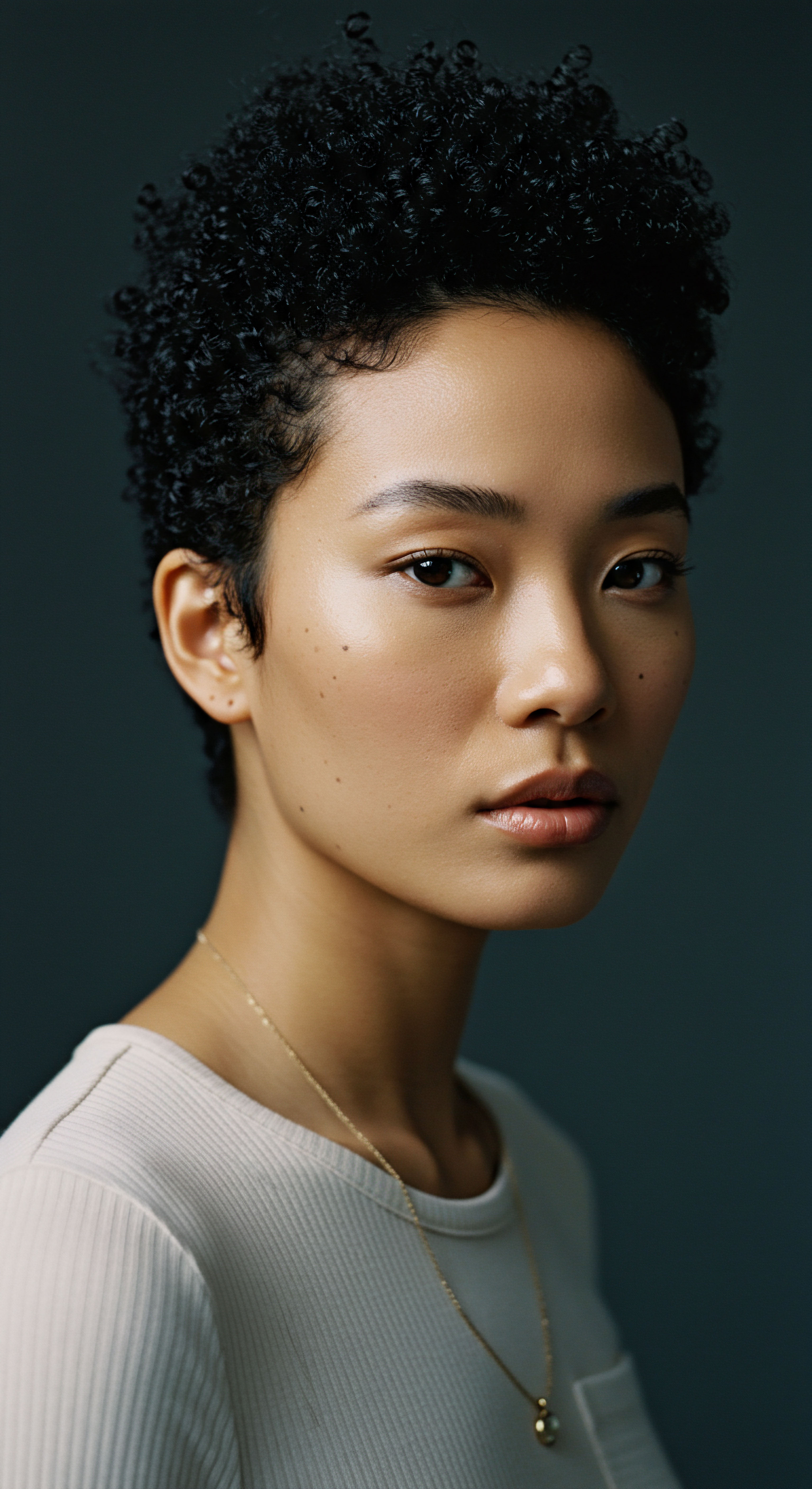
Roots
The quiet hours of night hold a peculiar sway over our world, a time when the sun retreats, and a different rhythm takes hold. For generations, across continents and through the mists of time, this nocturnal canvas has also been a silent stage for the tending of curls. It is a curiosity, perhaps, to consider how the simple act of sleep, a universal human experience, could intertwine so deeply with the delicate needs of textured hair. Yet, a thoughtful glance backward reveals that the protection of curls during slumber is not a modern innovation born of internet wisdom; rather, it is a timeless whisper carried through the ages, a practice rooted in the very understanding of hair’s vulnerability and its intrinsic connection to identity and well-being.
This journey into the historical customs that cradled curls through the night begins not with a single origin point, but with a recognition of humanity’s shared ingenuity. From ancient civilizations that meticulously recorded their daily lives to Indigenous communities whose knowledge was passed down through oral traditions, the impulse to preserve and honor hair at rest appears as a persistent theme. The challenges faced by textured strands—the tendency towards dryness, the susceptibility to tangling, the desire to retain definition—were observed and addressed with a wisdom that predates contemporary scientific terminology, yet aligns remarkably with its principles.

Ancient Civilizations and Hair Protection
Long before the advent of satin bonnets and silk pillowcases as we know them, early societies recognized the physical fragility of hair, particularly its tendency to suffer from friction against rough surfaces during sleep. The materials at hand, whether finely woven plant fibers or animal skins, became the earliest forms of nightly protection. These practices were often interwoven with broader cultural values concerning cleanliness, status, and spiritual connection.
- Egyptian Traditions ❉ In ancient Egypt, where hair was revered and often adorned with elaborate styles, the nighttime ritual held significance. Individuals, particularly those of higher status, would apply rich oils and balms, often infused with aromatic resins, to their hair before wrapping it in linen cloths. These coverings served a dual purpose ❉ to keep the hair clean and protected from dust, and to preserve intricate daytime styles, thus reducing the need for daily re-styling. This care ensured hair remained supple and less prone to breakage.
- Roman Customs ❉ Roman women, celebrated for their complex hairstyles, also understood the need for nocturnal hair preservation. Hairnets, sometimes crafted from gold thread or delicate fabrics, were commonly used to secure elaborate coiffures and prevent them from unraveling overnight. These nets helped maintain curls and waves, which were often achieved through heat or elaborate braiding during the day, minimizing damage and maintaining their aesthetic appeal for the following day’s activities.
- African Ancestral Practices ❉ Across various African cultures, hair was (and remains) a powerful symbol of heritage, status, and identity. Nighttime hair care was a communal and often ritualistic affair. Braiding, twisting, and knotting techniques were applied to secure hair, often after moisturizing with natural oils like shea butter or palm oil. These protective styles, worn overnight, shielded the hair from friction, retained moisture, and helped curls maintain their integrity, ensuring the longevity of styles and the overall health of the strands.
Early civilizations instinctively grasped the need for nighttime hair protection, utilizing available materials and practices to preserve the integrity and beauty of textured strands.

The Symbolic Weight of Hair at Rest
Beyond the purely practical considerations of preserving style and preventing damage, the nighttime care of hair also carried significant symbolic weight. In many cultures, hair was seen as a conduit to spiritual realms, a crown of one’s being, or a repository of strength and wisdom. The act of tending to it, even in the private moments of sleep preparation, was therefore imbued with a deeper meaning. It reflected respect for the body, a connection to ancestral practices, and sometimes, a protective measure against negative influences believed to roam in the dark.
This reverence meant that the methods employed were not merely utilitarian. They were often gentle, deliberate, and performed with a sense of quiet devotion. The materials chosen, whether fine linen, animal skins, or later, more refined silks, were selected not only for their protective qualities but also for their perceived purity or their ability to honor the hair. This blend of practicality and profound respect forms the foundational understanding of why nighttime hair care customs persisted and evolved through history.

Ritual
As the sun dips below the horizon, and the world quiets, a distinct kind of wisdom emerges, a knowing born from daily rhythms and the practicalities of tending to what matters. For those with curls, this shift from day to night has historically signaled a time for particular care, a set of actions designed to preserve the day’s work and prepare for the morning’s unveiling. This section steps into the very heart of these practices, exploring the techniques and tools that became integral to nighttime hair care, transforming simple acts into meaningful rituals. It is a space where practical knowledge, honed over centuries, truly shines.
The methods employed were not arbitrary; they were born of observation and a deep understanding of how textured hair behaves. The aim was consistently to minimize friction, retain moisture, and keep curls from tangling or losing their form. These objectives, seemingly modern, echo through historical accounts and continue to shape our contemporary approaches to nightly hair protection.

Techniques for Nocturnal Curl Preservation
The core of historical nighttime hair care for curls revolved around a series of physical manipulations designed to secure the hair and prevent damage. These techniques varied across cultures but shared common principles of containment and gentle handling.
One widely practiced method was Braiding. Whether in simple plaits or more complex cornrows, braiding hair before sleep served as an exceptional protective measure. The interweaving of strands created a compact, less vulnerable structure, significantly reducing tangling and friction against sleeping surfaces.
For many African and diasporic communities, specific braiding patterns were not only protective but also held cultural significance, often reflecting social status, age, or marital standing. These braids would then be covered, further shielding the hair.
Another common technique involved Twisting. Similar to braiding, two-strand twists or Bantu knots provided a contained structure that minimized manipulation. These twists helped to maintain curl definition and prevent stretching or frizzing of the hair overnight. The application of natural oils or butters often preceded these twisting rituals, sealing in moisture and adding a layer of lubrication against potential friction.
The practice of Wrapping Hair was also widespread. This involved carefully arranging the hair around the head, often in sections, and then securing it with a cloth. This technique, particularly effective for longer or looser curl patterns, kept the hair flat and protected, preventing it from becoming crushed or tangled during sleep. The material of the wrap was crucial, with smoother fabrics preferred for their ability to reduce friction.

The Role of Protective Head Coverings
The choice of material for nighttime head coverings was a critical aspect of historical hair care. While modern science points to the benefits of silk and satin, historical communities utilized the best available smooth fabrics to shield their strands.
| Material Linen |
| Historical Context Ancient Egypt, parts of Europe |
| Hair Protection Benefit Absorbent, but finer weaves offered some friction reduction; kept hair clean. |
| Material Cotton (fine weave) |
| Historical Context Various cultures, particularly as it became more accessible |
| Hair Protection Benefit Softer than coarser fabrics, though still prone to moisture absorption and friction. |
| Material Silk |
| Historical Context Ancient China, trade routes to Europe and Asia |
| Hair Protection Benefit Extremely smooth, minimal friction, retained hair's natural moisture. |
| Material Animal skins (softened) |
| Historical Context Indigenous communities globally |
| Hair Protection Benefit Provided warmth and some barrier protection; texture varied. |
| Material The selection of materials for nightly hair coverings evolved with cultural exchange and technological advancement, always aiming to reduce friction and preserve hair integrity. |
The use of Silk, originating in ancient China, slowly made its way across trade routes, becoming a highly prized material for its luxurious feel and practical benefits. Its smooth surface minimized friction, allowing hair to glide rather than snag, thereby preventing breakage and preserving moisture. Even in societies where silk was not readily available, the principle of a smooth, non-abrasive surface was understood, leading to the use of finely woven cloths or specially prepared animal hides.
Nighttime hair care practices, from braiding to wrapping, were deliberate actions rooted in understanding hair’s vulnerability to friction and moisture loss.

Nighttime Moisturizing Practices
Beyond physical protection, the application of nourishing substances was a widespread custom. Various cultures utilized locally available oils, butters, and plant extracts to condition hair before bed. These natural emollients provided a protective barrier, sealed in moisture, and softened the hair, making it less prone to tangling and breakage.
For instance, in West African communities, Shea Butter was (and remains) a staple. Its rich, emollient properties made it ideal for coating hair strands, providing intense moisture and a protective layer against the drying effects of the environment and friction from sleeping surfaces. Similarly, Coconut Oil was prevalent in many tropical regions, valued for its ability to penetrate the hair shaft and reduce protein loss. These practices were not just about aesthetics; they were about maintaining the health and resilience of the hair, ensuring it could withstand daily styling and environmental stressors.

Relay
What deeper currents flow through the enduring practices of nighttime hair care, connecting ancient wisdom to our contemporary understanding of textured strands? The journey from practical customs to profound cultural statements and scientific validation reveals a rich interplay of forces. This final segment seeks to unearth the intricate connections that elevate historical nighttime hair rituals beyond mere vanity, placing them squarely within the realm of identity, resistance, and the timeless pursuit of well-being. It is here that the scientific rationale for ancestral practices becomes clear, and the legacy of these customs takes on a heightened significance.
The continuity of these practices, despite centuries of societal shifts and external pressures, speaks volumes about their inherent value. They are not simply relics of the past; they are living traditions, constantly reinterpreted and reaffirmed, particularly within communities whose hair has often been misunderstood or marginalized.

The Science Behind Ancestral Practices
Modern trichology and textile science offer compelling explanations for the efficacy of historical nighttime hair care customs. The primary culprits for hair damage during sleep are friction and moisture loss. When hair, especially textured hair with its raised cuticle layers, rubs against rough surfaces like cotton pillowcases, it causes the cuticle to lift, leading to frizz, tangling, and ultimately, breakage. Cotton, being a highly absorbent fiber, also wicks moisture away from the hair, exacerbating dryness.
Conversely, smooth fabrics like silk and satin, historically used in various forms of head coverings, significantly reduce this friction. Their tightly woven, smooth fibers allow hair to glide effortlessly, minimizing cuticle damage and preserving the hair’s natural moisture. This scientific understanding validates the ancient preference for such materials, even if the precise scientific terminology was absent at the time. The historical application of oils and butters before sleep also aligns with modern hair science, which emphasizes the importance of emollients to seal the cuticle, prevent moisture evaporation, and provide a lubricating layer against friction.
Historical nighttime hair care customs, driven by instinct and observation, find powerful validation in contemporary scientific principles concerning friction, moisture, and hair integrity.

Colonialism, Identity, and Hair Resistance
The relay of nighttime hair care customs is incomplete without addressing the profound impact of colonialism and the subsequent struggle for hair autonomy, particularly within Black communities. During periods of enslavement and colonial rule, traditional African hair practices, including protective nighttime rituals, were often suppressed or devalued. Enslaved Africans were frequently forced to conform to European beauty standards, which often involved straightening textured hair, leading to significant cultural and physical damage.
Despite these pressures, many traditional practices, including nighttime hair wrapping and braiding, persisted as quiet acts of resistance and cultural preservation. These customs became a way to maintain a connection to heritage, assert identity, and protect hair that was often subjected to harsh conditions and negative perceptions. The simple act of wrapping one’s hair at night became a private reaffirmation of self, a silent defiance against narratives that sought to diminish Black beauty.
A notable example of this resilience is seen in the enduring practice of head wrapping, which evolved from functional protective wear into powerful symbols of cultural identity and political expression. Even as outward displays of traditional hair were discouraged, the private, nocturnal rituals continued, safeguarding not only the physical strands but also the spirit of a people. The contemporary resurgence of natural hair movements globally is, in many ways, a continuation of this historical relay, a conscious reclamation of ancestral practices and a celebration of textured beauty.

A Data Point on Cultural Impact and Hair Perception
The societal implications of hair perception, deeply rooted in historical biases, continue to shape experiences. A 2016 study published in the journal Social Psychological and Personality Science by researchers at The Perception Institute revealed compelling insights into biases against Black women’s hair in the workplace. The study found that Black Women with Natural Hairstyles Were Perceived as Less Professional and Less Competent Than Those with Straightened Hair, and Were Also Less Likely to Be Recommended for Job Interviews. This stark finding underscores the pervasive nature of historical beauty standards and the very real consequences for individuals who choose to wear their hair in its natural, textured state. The enduring need for protective styles, including those for nighttime, becomes not just a matter of hair health, but also a quiet act of defiance against systemic biases, preserving the hair that, for many, is a visible declaration of identity and heritage.

The Modern Echo of Ancient Wisdom
Today, the legacy of historical nighttime hair care customs is palpable in the widespread adoption of silk pillowcases, satin bonnets, and various protective styles like twists and braids for sleep. What was once born of necessity and intuitive understanding is now bolstered by scientific evidence and a renewed appreciation for natural hair. The global natural hair movement has played a crucial role in bringing these practices back into the mainstream, not as mere trends, but as foundational elements of a healthy hair regimen.
The wisdom passed down through generations, often through quiet observation and shared experiences, has found its contemporary voice. From the intricate braiding patterns of ancient African communities to the linen wraps of Egyptian nobility, the core principles remain unchanged ❉ protect, moisturize, and preserve. These customs remind us that hair care is more than just a routine; it is a connection to history, a celebration of identity, and a gentle act of self-preservation that transcends time.
- Silk Bonnets ❉ These modern adaptations directly descend from historical head coverings, providing a smooth, low-friction environment that shields curls from damage and moisture loss during sleep.
- Pre-Sleep Oiling ❉ The practice of applying natural oils or leave-in conditioners before bed mirrors ancient customs of using botanical extracts and butters to seal in moisture and soften strands.
- Protective Styles for Sleep ❉ Braids, twists, and pineapple methods, often secured with soft ties, are direct continuations of historical techniques used to keep hair contained and minimize tangling overnight.

Reflection
To consider the enduring customs of nighttime hair care for curls is to peer into a quiet corner of human history, a space where practical wisdom and profound cultural significance intertwine. It reveals a continuous thread of care, resilience, and ingenuity that stretches from ancient hearths to contemporary bedrooms. These practices, seemingly simple, hold within them stories of identity, acts of quiet preservation, and a deep, intuitive understanding of hair’s delicate nature. They remind us that true wisdom often resides in the gentle, repeated gestures that honor our heritage and nourish our very being.

References
- The Perception Institute. (2016). The “Good Hair” Study ❉ Explicit and Implicit Attitudes Toward Black Women’s Hair.
- Opoku, R. (2018). African Hair ❉ The History of Hair in Africa and the Diaspora. Independently published.
- Byrd, A. D. & Tharps, L. L. (2014). Hair Story ❉ Untangling the Roots of Black Hair in America. St. Martin’s Griffin.
- Sherrow, V. (2006). Encyclopedia of Hair ❉ A Cultural History. Greenwood Press.
- Balsam, S. (2016). The Science of Hair Care. Allured Business Media.
- Tabor, M. (2004). African American Hair ❉ A Cultural History. Rizzoli.
- Marsh, C. (2019). The History of African Hair ❉ A Journey Through Time. Independently published.
- Robbins, C. R. (2012). Chemical and Physical Behavior of Human Hair. Springer.